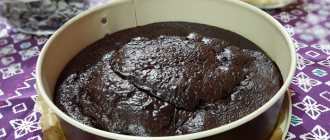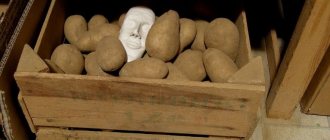Hello dear friends! In this article, I want to share my experience of how we learned to make Brynza, and how it helped us out in selling dairy products, since its taste is unique, and many sellers simply don’t know how to make homemade cheese.
Let me start with the fact that we were prompted to this experiment by the well-known problem of dairy farmers: “There is nowhere to put the cottage cheese.” For some reason it is in less demand and sells out at about 1 liter of cream/1 kg. cottage cheese, and in the summer 1/0.5 kg (various reasons: summer residents do not have refrigerators, they are busy with gardening and have no time to make dumplings and bake cheesecakes, it’s just too hot to eat at all, etc.).
We need to look for a place to sell. These are, as a rule, resellers, dumpling shops, bakeries, etc. The price there is the same from year to year, from 80 to 50 rubles. per kilogram (this information is also current as of August 2020), you will bring the rest home and feed it to the piglets and chickens. Anyone who does this understands what I mean. In a word, it was unprofitable, so I had to look for more profitable products.
The idea was just cheese. We ordered 30 packs of pepsin on the Internet (a lot, because delivery was expensive for smaller quantities), and with it, fortunately for us, a brochure with recipes for homemade cheeses came as a gift.
And from that moment they began their self-education..., they transferred a lot of milk...
But if you use my guide, I think the road to homemade cheese will not be so bumpy.
I will say about pepsin that the cheapest 30 ruble bag is designed for 100 liters of milk.
It is of plant origin, but there is also an animal one, the cheese made from it is even tastier, but it is more expensive, and it is not profitable for production, since you need to find connoisseurs of taste with a good budget to justify the costs. More often we have to focus on the middle class.
In the brochure that was sent to us with pepsin, it is clearly stated that “Brynza” is a cheese made from sheep’s milk. And “Domashny” is made from cow’s milk, we will make it, but the cooking technology is no different, it’s just that many of our customers call it Brynza, but this is not so.
Shelf life in the refrigerator
Like any cheese, after purchase the cheese is usually placed in the refrigerator.
How long it will remain fresh there depends on a number of nuances. Young cheese without brine remains usable for 2-7 days. The reason is that feta cheese does not have a hard crust, so bacteria from the outside easily penetrate into it.
Very quickly, within 2-3 days, the product will deteriorate in a plastic container. If you wrap it in cellophane, the effect will be even worse: the piece will “suffocate” and become tasteless.
Young cheese will stay fresh for up to 5 days if it is tightly packed in foil and placed in a pan (necessarily enameled) with a tight-fitting lid.
Fully ripened, salted cheese, wrapped in foil, will not spoil in the refrigerator for 2-3 weeks.
How to cut for storage + ways to use cheese preparation
This item contains both a collection of strict rules and several interesting storage experiments. All the tips will be useful on the farm.
Several important rules for storing hard cheeses in the freezer:
- Be sure to pack the product, otherwise it will become airy and absorb foreign odors. Use airtight plastic containers, a sheet of foil, or parchment.
- By the way, it is better to place cheese in a separate compartment of the freezer, away from fish, meat and other products with a pronounced odor.
- Mark the date of placement in the freezer on the package of cheese so that you do not forget about the product and do not accidentally use it after the expiration date.
- Never refreeze.
- Do not put different types of cheese in the same package so that their smells do not mix.
- If the purchased cheese is already wrapped in a plastic bag, then there is no need to replace it with a new one. This is especially true for elite varieties of blue cheese.
- Do not attempt to store expired product at low temperatures.
How to cut cheese for storage, different ways:
- The most convenient form of freezing is cubes. They are then used in different types of dishes: soups, salads, baked goods.
- Whole cheese is cut into pieces of 250-500 g.
- The difficulty of storing cheese in slices 1-1.5 cm thick is that the pieces stick together. The method is long, but it works: just make partitions between the parchment plates.
- Try freezing grated cheese. It is distributed in portions into bags, all the air is squeezed out, and secured (it’s good if there is a fastener). Another option is to make grated cheese from an already thawed whole block.
On the issue of defrosting It should happen gradually. First, remove the product and place it on the bottom shelf of the refrigerator. After a few hours, remove the cheese from the appliance and let it thaw on the counter. The more evenly the thawing process occurs, the more the type of cheese will be close to the original.
Now about the main thing: how to use defrosted cheese further? Snacks made from it no longer look so aesthetically pleasing, so distribute the fermented milk product over hot sandwiches, sandwiches, the shavings will be useful for filling pizza or pasta, the cubes will quickly dissolve in the cheese soup.
Buy cheese for your own pleasure and enjoy the taste longer than the manufacturer prescribes. Freezing can significantly extend the shelf life of the product.
Bryndza at home from cow's milk and general principles of its preparation
• To prepare a tasty and high-quality product such as feta cheese, it is necessary to select homemade ingredients that will give this dish a special taste, nutritional value, and bring incredible benefits to its consumer.
• Only fresh milk should be used for making cheese.
• Of course, to make feta cheese, you can use a pasteurized product (meaning milk), but in this case the nutritional value of the future feta cheese will decrease and it can safely be classified as a dietary low-fat food.
• The starter for cheese can be vinegar or pepsin (which can be purchased at any pharmacy).
• The composition of feta cheese should include the main components, such as milk, salt and sourdough.
• The color of the cheese should be white, and the consistency should be soft and slightly brittle.
• The fewer holes and voids in the cheese, the better and healthier this tender and appetizing dish, prepared according to all the rules, will be considered.
Homemade cheese recipes
Making cheese using pepsin
Pepsin is a digestive enzyme that promotes milk coagulation.
To prepare homemade cheese using pepsin, you need 3 liters of milk, a little pepsin (literally on the tip of a knife), 1 tbsp. a spoonful of salt and a liter of water.
Preparation:
- Heat the milk (to prepare feta cheese, it is better to use homemade cow or goat milk) to 30 °C.
- Dissolve pepsin in a glass of water and pour into milk, always stirring it.
- If the milk has curdled, remove from heat.
- Place the original cooled cheese mixture onto cheesecloth.
- After the whey has drained, roll up the gauze and place the mixture under a press.
- Dip the cheese into a saline solution (1 tablespoon per liter of water).
A simple recipe for cow's milk cheese at home
Required: 3 liters of cow's milk, 3 tbsp. spoons 9% vinegar, and of course 1 tbsp. spoon of salt.
When stored for up to 30 days, it decreases significantly, then stabilizes, after 120 days it increases, and by 180 days of storage it stabilizes again.
Why do you need brine?
The shelf life of feta cheese increases significantly if it is kept in brine, that is, the brine in which it was ripened. According to GOST, it is one and a half months. The minimum shelf life is 2 weeks. If the cheese was sold in dry packaging, you can place it in a homemade brine. This is done like this:
- Dissolve 225 g of coarse salt in 3 liters of warm water. If desired, dry spices are added to the brine, for example: dill, pepper, caraway seeds, parsley, garlic.
- Pieces of cheese are placed in a clean glass jar and poured with the prepared mixture so that it completely covers the cheese.
- The jar is placed on the middle shelf of the refrigerator.
If there is a lot of cheese, after a month the brine for long-term storage of feta cheese should be drained and replaced with a new one of lower concentration (30 g of salt per 3 liters of water).
To remove excess salt from the cheese, soak it in cool water or milk for 5-10 minutes before serving.
How else do you make brine for cheese?
If you are faced with the task of where to place the cheese for the winter, then you can prepare a different composition. Sugar is added to it to preserve the product; it helps preserve the product without changing its properties. It will remain fresh even after 2-3 months. The correct version of brine for preservation is made from:
- distilled water – 1.5 l;
- table salt – 200 ml;
- sugar – 150 ml.
The following instructions will help you make a brine option for storing the product for a long time:
- place all the necessary ingredients in the tank;
- mix all the contents of the container and place it on the stove;
- boil the solution and immediately remove it from the heat;
- Cool the brine to room temperature (+20…+25 °C).
This brine is suitable for both initial pickling and long-term storage. Unlike other options, you won't need to soak the dairy product in boiled water for months to get rid of excess salt.
How to store cheese in brine
If you bought cheese placed in a container with brine, you should not remove it from there and transfer it to another container, because the brine is prepared in such a way that the cheese remains fresh in it for a long time.
How many? Each package should contain information from the manufacturer on how to store the product and for how long. These deadlines must be adhered to. And when cutting off another slice from the cheese, the rest of the piece is put back into the brine and put in the refrigerator.
Bryndza is stored at a temperature of 1-5°C, and it is the refrigerator that can create such conditions.
Sometimes, for some reason, the housewife pours out the brine. Then she should make it herself using a very easy recipe.
To do this, pour cold water into the container and add enough salt to get a brine of 18-20 percent strength, that is, take 180-200 g of salt per 1 liter of water. This liquid is poured into cheese.
Containers for storing cheese must be glass. Many people store it in plastic containers, but this is not the best option, since the cheese in the brine continues to ripen, and the chemicals from the plastic will pass into the liquid and into the product. Therefore, plastic containers are chosen very carefully.
Cheese cheese can be stored in a 20% saline solution for a very long time. To prevent it from souring, the brine must be changed monthly, but each time making it weaker. The final salt concentration in the water should be 15%.
Step-by-step instructions for making homemade cheese:
- Heat the milk to a temperature of 38 degrees; an ordinary human thermometer is perfect for measuring.
Or pasteurize (heat to 80 degrees for 10 minutes), and then cool to a temperature of 35-38 degrees
- Preparing the starter:
We take the required part for your liter of pepsin, dissolve it in about 50-100 grams. boiled water at room temperature. For reference, I’ll say that for ten liters of milk this is a mound on the tip of a knife, or a mound the size of a notebook square.
You need to add a little more old leaven.
- After the starter is completely dissolved in water, you need to add it to the milk, stirring it vigorously.
- We wait from 20 to 120 minutes (depending on the temperature and properties of the milk) until the clot forms.
We check the clot for fracture. The break line should be smooth and sharp, not curdled. Serum should appear along the edges of the clot, but this is not always clearly visible. It is better to scoop out a small hole with a teaspoon; the separated whey will settle in it.
- Separating whey and a dense clot are a signal for further action. According to the technology, you need to cut a pattern in the form of cells into cubes of 2 cm in size with a knife in the clot. But this is according to the technology, and in general the result will be the same if you stir the clot well just with a slotted spoon.
- We begin to heat to a temperature of approximately 40 degrees. It happens that sometimes you need a little warmer, so we heat it up, stirring constantly over low heat. On average, this stage can take about 10 minutes.
We are waiting for the moment when the curdled milk begins to shrink and gather a little into lumps, while the whey begins to separate well. At this moment, if you squeeze the sour milk between your fingers, it will “crunch” like grapes with a similar action.
It is important not to overdo it here, as overheated yogurt will cause our cheese to crumble.
If you want a softer cheese, you can turn off the gas as soon as you notice active whey separation.
- After turning off, let stand for about 5 minutes. During this time, the cheese mass settles to the bottom.
- Now we begin to drain the whey, first not into the final cheese mold, but into a colander covered with a napkin. When most of the whey has gone, transfer what is left into the cheese mold.
I recommend the mold for Adyghe cheese, as it has a lot of advantages: it has a tray for draining the whey, there are different sizes of this model on sale, a comfortable handle, it fits well in the refrigerator for further cooling and flowing, after it you get a beautiful, even mesh pattern, and also the ideal even shape of the wheel, if you are making several wheels at the same time, then the shapes of the same diameter are tightly placed on top of each other; the bottom has a concave shape, also with a pattern that will be imprinted on the bottom wheel.
- After placing the cheese in the mold for the first time after three minutes, shake it out into the palm of your hand and turn it over in the mold with the other side. Now sprinkle the top of the cheese with a good pinch of salt.
We add salt only when the cheese is already formed, otherwise there will be no smooth texture, and if you add salt in the yogurt state, the cheese will be in cracks from the separated whey. It should be salted from the surface, then it will be a single whole shape as in the photographs
- After 5 minutes, turn the cheese over for the last time, and also add a good pinch of salt (don’t be afraid to over-salt, the salt will go away with the whey)
- We drain the whey from the tray, cover the top of the cheese with a bag or a plate of suitable diameter (so as not to absorb odors), put it in the freezer for 30 - 50 minutes, for intensive cooling and good subsequent storage. And then put it in the refrigerator for another couple of hours.
- Then take it out of the mold and put it into a bag, and then back into the refrigerator.
How to preserve cheese?
To ensure that cooked cheese does not spoil for as long as possible and retains its beneficial substances, you need to learn how to store it correctly. For this you will need:
- brine;
- storage container;
- salt;
- sugar;
- textile;
- foil.
The higher quality the homemade cheese, the longer it will be stored.
It is important that it does not release large amounts of moisture. Its packaging should in no case be raised or contain sticky crumbs.
When cheese crumbles or dries out on different sides, there is a chance that it has been cooked for a relatively long time.
Therefore, it is better to leave the cheese in the brine in which it was made. It will serve as an additional means of protecting the fermented milk product, a kind of preservative that protects it from premature spoilage. The cheese and brine are tightly sealed in a storage container and remain edible for several weeks. If the cheese was purchased separately without brine, you can make it yourself at home by preparing a lightly salted solution. You can also leave the cheese in a plastic container, after wrapping it in a damp cloth or aluminum foil. In addition, you can put a small piece of refined sugar next to it.
Before cutting the cheese, the knife should be doused with hot water. This way the product will not crumble when cutting.
Brine in cheese making: why is it needed?
Some types of cheese require ripening using brine solutions. Such cheeses are called, accordingly, pickled cheeses. These include the following varieties:
- Brynza;
- Feta and Fetax;
- Suluguni;
- Chechil.
The brine solution in which the fermented milk products in question are ripened is, as a rule, also used for their storage. This solution is also called brine. It is especially good to use the exact brine in which the product was matured. It is considered the most suitable for microflora.
Read on to learn how to properly prepare brine for pickling and storing cheese.
Subtleties of cooking
You can prepare Suluguni at home only if you follow the instructions step by step.
The entire technology is usually divided into two main stages, each of which consists of several steps.
- The first stage is devoted to preparing fresh curd cheese. The selected milk is fermented, after which the whey is separated from the product. The curd grains are placed under a press and salted.
- At the next stage, if the cheese is prepared at home, then it needs to be processed and melted. The curd product is cut into miniature fragments and melted. Then the viscous substance will need to be kneaded as if it were dough, stretched and formed into separate layers. For preparation you will definitely need pepsin - this is an enzyme that can be bought at the pharmacy. Gauze or other fabric will also be useful, with the help of which the solid part will be separated from the whey.
By the way, if Suluguni is prepared at a factory, then the manufacturer can make changes to the existing technology - this is not prohibited by law. Therefore, in order to attract a large number of buyers, the recipe is changing for the better.
However, there are sanitary standards in production, which means that milk must be pasteurized. It should be mentioned that during this process the ingredient loses important elements such as calcium salts and rennet, which are then added additionally. As a result, homemade cheese turns out more natural, and it’s easier to prepare.
It should be mentioned that even without being in brine, Suluguni is ready for consumption. Therefore, those who do not like to bother with cooking for a long time can complete the process when the milk is transformed into curd.
Storing purchased Olivier
As for purchased semi-finished products, when purchasing such a dish, you need to carefully look at the date it was made. But this is not an indicator of good quality. It is not yet known under what conditions it was produced, and what the storage temperature was before it came into your hands.
It is very important to pay attention to the fact that each salad that is in the refrigerated display case has its own individual spoon. Otherwise, pathogenic microflora can be transmitted through devices from a spoiled dish to a fresh one
Those salads that are sold in separate, portioned trays with the inscription “discount” are the most dangerous. Usually this is how they sell out dishes that are about to expire any minute.
Even if the manufacturer is proven and reliable, the purchased salad is fresh, you do not need to store it in the refrigerator until the next day. Now there is such an abundance of goods in stores, there is no need to stock up for future use. You need to purchase food immediately before lunch or a feast, and eat it right away. You should not store this dish further in the refrigerator.
How to store suluguni without a freezer
The composition of the cheese is balanced: it contains not only proteins, vitamins and minerals, but also beneficial microorganisms. That is why you should treat cheese storage wisely.
At room temperature, suluguni will spoil in a matter of hours. Therefore, place it on the bottom shelf of the refrigerator or in the fruit compartment, always at a constant temperature.
The most delicious suluguni cheese is sold in containers with brine. It also has the longest shelf life - about 1 month. During this time, you will definitely have time to enjoy the magnificent salty taste of the product.
Without brine, suluguni lasts only from 2 to 10 days. If the packaging indicates a longer period, be wary: most likely, it contains preservatives.
Measures to help the cheese not spoil:
- Ensure that the packaging is sealed.
- Replace the open pack with foil, parchment or special cheese paper, or use a container with a lid. And in a plastic bag or film the product will “suffocate”.
- If possible, store a block of soft cheese in brine, this will improve its taste.
- Periodically replace the storage brine with fresh one. This will prolong its freshness.
Buy suluguni in limited quantities, because fresh gourmet cheese is much tastier than defrosted or even just left in the refrigerator.
Storing hard cheeses
The name speaks for itself. Hard cheeses have a dense body that breaks easily. Examples of hard cheeses: Parmesan, cheddar, Kostroma, Swiss.
They are stored wrapped on the cut side with natural cloth, slightly moistened in lightly salted brine. The cheese is wrapped in foil or wax paper over the fabric. The cheese is then placed in a glass or ceramic container, which is placed on the bottom shelves of the refrigerator.
You can also use a lightweight storage option: wrap the cheese in a regular paper napkin and put it in a container. Each time after using cheese, the napkin must be changed and the container wiped dry.
A compromise packaging option could be a glass or enamel bowl covered with foil or a thick linen napkin. Place the cheese in it in parchment or cloth.
Hard cheeses are stored at temperatures from 0 to 5 degrees. If all requirements are met, this product will easily withstand storage for 4-5 weeks.
Hard cheeses are wrapped in parchment, cloth or wax paper for storage.
About freezing suluguni
Some housewives have adapted to freezing suluguni with minimal losses to the product:
- Transfer a single serving of cheese from the original packaging into a glass or plastic container that can be frozen. The container should be spacious, but not too spacious.
- Fill the suluguni with the original brine or table salt solution so that it is completely covered, but so that at least 1 cm remains to the top of the dish. This is necessary so that the container does not burst when the brine freezes and increases in volume.
- Place in the freezer.
- Defrost strictly in the refrigerator.
If the refrigerator design allows, use the special “freezing” mode. The faster the product hardens, the less its taste will suffer.
Try to eat the cheese within a month - there is simply no point in storing it longer. It is better to use defrosted soft cheese as part of dishes, for example, for filling in baked goods or salads.
Tips for choosing
High-quality cheese has a white or slightly yellowish tint. The presence of foreign colors indicates deterioration and technological violations in production. It is advisable to choose cheese in brine, so it will retain its taste and beneficial elements longer.
Fresh cheese does not have a hard crust. Its presence indicates long storage on the sales counter; it is better to refuse it. The composition must contain no preservatives. Only the presence of E509 hardener is permissible; it is harmless to the body. It is advisable to taste the cheese before purchasing. It is optimal to choose the fat content in the range of 25-50%; such a product will have an oily and soft structure. Even full compliance with the rules for storing cheese will not help preserve the completely beneficial properties of the delicacy. Therefore, it is advisable to buy it in small quantities and eat it immediately.
Share link:
How to preserve cheese at home
Recommendations for storing cheese at home are simple and accessible to everyone. Firstly, maintaining the optimal ratio of temperature and humidity in the surrounding space, and secondly, avoiding direct rays of the sun. If you follow all the rules, you can preserve the taste of cheese and beneficial properties.
When storing cheese, cheese experts consider maintaining an optimal temperature to be an important point. The average temperature suitable for storing almost all homemade cheese delicacies is +6...+8°C. Brine and soft rennet varieties are not recommended to be stored at temperatures above +4°C to avoid deterioration of their composition and structure.
Air humidity is important for storing cheese. If the humidity is less than 90%, then the cheese will dry out, and if it is higher, it will spoil. Preservation of the maximum amount of beneficial properties and vitamins in cheese at home depends on the variety.
Storing cheese in the refrigerator at home
In the refrigerator, you can regulate both temperature and humidity, and accordingly, you can preserve all the properties and taste of the cheese. It is better to store cheeses away from the freezer. The best place for hard cheeses is in the vegetable storage compartment. Cheese should be stored in the refrigerator wrapped in cling film. The tightness of the packaging ensures that the product does not become airy and does not absorb other odors.
Storing cheese at home without a refrigerator
Cheese can be stored and preserved without refrigeration. To do this you will need a wet cloth. You need to wrap the cheese in a clean cotton cloth, which must be pre-soaked in salt water and wrung out well. Place in a dark, well-ventilated, cool place.
Storing cheese at home in brine
Storing cheese in brine is considered an ideal storage method for feta cheese. Preparation of brine: dissolve salt (5 tablespoons) in cool water (1.5 l). Fill the cheese completely with brine and store in a cool place in an enamel container.
Storing different types of cheese at home
The shelf life of cheese depends on its specifics. Curd cheese cannot be stored in a plastic bag or film. It is recommended to store it in a glass or enamel container with a closed lid. In this case, the shelf life will be 5-7 days. With longer storage, it begins to dry out and lose its taste. For longer storage of curd cheese and soft cheeses, it is recommended to keep it in the freezer. There it can be stored for several months and will retain its original taste and beneficial properties.
Hard rennet cheeses are made on the basis of live bacterial starter - rennet enzyme for cheeses. They do not like high humidity, so it is recommended to store them in a dry place in a glass, enamel or porcelain container, wrapped in cling film.
Hard aged cheeses should be stored at temperatures from -4°C to 0°C, and air humidity should be 85-90%.
Below is a method for increasing the shelf life of cheeses of this type:
1. Dry the cheese on all sides. Using a heated knife or spoon, smooth out any unevenness and cracks, if any. 2. In a water bath (the dish should be larger in size than the cheese), melt regular paraffin candles (several pieces) or real wax. 3. Dip the bottom half of the cheese head into the wax, remove it and, after the wax hardens on it, do the same with the other half. The cheese should be covered with wax without gaps, cracks or air bubbles. 4. Lay a clean cloth on a wooden board or plate, put cheese on it and place in the refrigerator.
It is recommended to store Adyghe cheese, feta cheese or suluguni in a stainless steel or enamel container (the enamel must be intact and undamaged). Bryndza can be kept in strong brine for up to 2 months without losing its taste.
Having knowledge of cheese storage, you will always have a healthy and high-quality product on your table!
https://hozotsek.ru/kak-hranit/brynzu.htmlhttps://uborka-v-dome.ru/kulinariya/kak-sdelat-rassol-dlya-syra.htmlhttps://syrspec.ru/recepty/kak- mozhno-sdelat-rassol-dlya-syra-v-domashnih-usloviyah.htmlhttps://cheeseland.ru/articles/16-kak-sohranit-syr-v-domashnih-uslovijah.html
10 Feb 2021 edypravilno 39
Storing cheese in brine
Brine cheese is stored at home in several ways. The shelf life of the product depends on the ambient temperature. The shortest period for storing cheese is indoors. Placing it in the freezer allows you to use the product for a long time without losing its taste.
At room temperature
Like all fermented milk products, soft cheese is a perishable food. If feta cheese or feta cheese is kept in its original tight packaging in the kitchen, then it is considered edible for 1 day. If the container is unsealed, it is advisable to eat its contents within 4-5 hours. Cheese cheese in brine is stored longer, even if the air temperature is within +20...+22°C. It can be used for 2 days.
In a refrigerator
If the container with purchased salted cheese is opened, then the product can be stored on the refrigerator shelf for 4-5 days. When sealed, the contents of the container are considered suitable for more than 10 days. When placing a container in the refrigerator, preference should be given to a shelf located in the middle. The most suitable temperature for storing fermented milk products is maintained there.
If you transfer a block of cheese from the factory packaging into an enamel pan and tightly cover the top with foil, it will remain usable for 2 weeks. It is not recommended to transfer cheese or feta into cling film. They will immediately begin to deteriorate in polyethylene. Almost the same effect will be observed when placing the product in a plastic container. The contents of the container must be eaten within 2-3 days. Otherwise, the cheese will have to be thrown away.
Homemade brine will help you preserve cheese for 0.5 months. You can choose any brine recipe, but the shelf life of the product depends on the concentration of salt in the liquid.
In the freezer
Placing soft cheeses in the freezer is considered a last resort. Freezing followed by thawing has a bad effect on the consistency and taste of the product. The cheese becomes dry and begins to crumble a lot.
For frozen storage, the cheese block is placed in a plastic bag or wrapped in foil material. Place the package on the bottom shelf of the freezing unit. There it can lie for up to 7-8 months.
General rules and recommendations
The shelf life of soft cheese will not coincide with the shelf life of hard cheese. Storage conditions depend on the variety. But there are standard rules that will help protect fermented milk products from spoilage.
- To prevent cheese from molding, it must breathe. It’s not a good idea to buy a packaged product, cut into pieces and wrapped in food grade cellophane. In this form, the shelf life of the cheese is immediately reduced by half, microbes attack it more actively, and the taste deteriorates.
- Parchment paper, which is usually used for baking, will help you store cheese properly after purchase. If the goal is to preserve the “fermented milk” for as long as possible, the cheese in paper is placed in a loose bag or container. These measures will prevent rapid drying.
- Storing cheese in the refrigerator is the best option. It is optimal to place the product on a shelf near the fruit and berry compartments. But it’s better not to put products in the door or next to the freezer.
- Mold is not a reason to say goodbye to the entire piece of cheese. Usually it forms on one of the surfaces. Therefore it is easy to cut. The rest should be packed in baking paper.
- Another condition that answers the question of how to keep cheese fresh in the refrigerator for a long time is correctly set temperature. From five to seven degrees Celsius with air humidity not exceeding 89-91%.
- Buying a glass or ceramic cheese pan will extend the shelf life in the same way as placing a piece of refined sugar next to the cheese.
It’s too early to worry if the refrigerator is out of order. Cheese can be perfectly preserved both without a refrigerator and without a freezer. It is enough to wrap the product in natural material soaked in saline solution. The wrapped piece is placed in a container without a lid and placed in the pantry at room temperature.
There are exceptions to every rule. The recommendations listed do not apply to pickled fermented milk products. It can not spoil only in its own brine. You cannot prepare the brine with your own hands or try to influence the shelf life. Among other things, pickled cheese must not be placed in the cold.
Types of cheeses and their characteristics (click to enlarge)
What to remember
- Choose whole, hermetically sealed products. Vacuum packaging can preserve cheese for 6 months.
- Store in the refrigerator. Fermented milk products are stored at room temperature for several hours. Then it becomes unfit for consumption.
- Store in brine. To extend the shelf life of cheese, it should be stored in a 20% saline solution. If necessary, you can soak it. Can be stored in salted milk for a delicate taste.
- Freeze cheese . To extend its shelf life, feta cheese can be frozen and used for making salads and baking.
What you need to do to preserve the properties of mozzarella
There are several rules that, if followed, can extend the life of an excellent Italian product:
- It is recommended to store this cheese in a cool place where the temperature does not exceed +7°C.
- Mozzarella is placed in brine so that the cheese retains its elastic structure.
- It should be stored in a glass container with a tightly closed lid.
- The cheese must be immersed in the brine in such a way that no part of it remains exposed to air.
- Once the packaging is broken, this product can be stored in the refrigerator for no more than 3 days.
Since mozzarella cheese in Italy is intended to be consumed the same day it is made, it is not designed for long-term storage. Pickled cheeses have a unique flavor and that is why they are so popular all over the world. People who appreciate its qualities are interested in knowing how to store mozzarella at home. So that such a wonderful cheese does not lose its beneficial qualities and does not lose that unique taste note for which it is so loved, familiarize yourself with the storage table.
| Storage method | Shelf life |
| After opening the package | no more than 12 hours |
| In the refrigerator in brine and glass container | 3 days |
| Frozen | 1 month |
The benefits and harms of fermented milk products
Brynza at home turns out just as tasty as from the store. To make it, you can take any milk - cow, goat, sheep and even buffalo. When prepared from store-bought milk in dairy factories, the cheese is aged for at least 2 months; homemade cheese can be eaten after 7-10 days.
Bryndza cheese is a source of milk protein, calcium, which strengthens bones and ligaments. Consumption 4-5 times a week improves intestinal function, eliminates bad breath, and normalizes acid-base and water-electrolyte balance. This product slows down aging, prevents the formation of the first wrinkles, improves joint mobility and increases muscle tone.
Having mastered the recipe for cooking at home, you will not only be confident in the safety of the product, but you will also be able to lose weight. A cheese breakfast blocks the feeling of hunger for a long time, which means you can avoid having an extra snack before lunch.
If you have diseases of the stomach, kidneys, hypertension, gall bladder and blood vessels, you can eat cheese, but it is better to limit yourself to a small piece - 20 g, no more than 2-3 times a week. This is due to increased salinity. To minimize harm, soak the cheese in boiling water or hot milk and boil for several minutes. But such methods will only help for homemade cheese, which has been kept in brine. If salt was added when introducing the starter, it is practically impossible to neutralize it.
Attention! Cheese cheese is not eaten before bed. After such a snack, it is difficult to get enough sleep - falling asleep is disrupted and nightmares occur. Despite the benefits of fermented milk product, it cannot replace kefir.
Useful properties of cheese
When purchasing a product in a store, they usually rely on the shelf life indicated on the original packaging. If you purchase homemade cheese from your hands, it must be carefully inspected. How do you know if a product is of good quality?
Pay attention to the color. It should be smooth and white. Lightly press the cheese with your fingers
The fresh product is moist to the touch, moderately soft and elastic. Ask the seller to cut off a small piece. Good quality cheese breaks, but does not crumble, and does not stick to the knife. The section shows multiple irregularly shaped pores and rare “eyes”. Smell the cut piece and taste it. Fresh cheese has a characteristic sour milk smell and salty taste.
Damaged goods and products whose shelf life is approaching the end show the following symptoms:
- crumbles or sticks to the knife when cutting;
- dry areas, yellow spots, cracks appeared on the surface;
- yellowish tint;
- bitter taste and unpleasant odor.
Spoiled cheese should not be eaten under any circumstances. This will lead to serious poisoning.
Benefits of feta cheese:
- is able to normalize digestion, since it contains vitamins of group B, as well as A, E;
- does not undergo heat treatment, which allows you to preserve most useful substances and microelements (Fe, S, P, R, Mg, Ca);
- Thanks to the sufficient amount of calcium, which is contained in an easily digestible form, it is very beneficial for the skeletal system and teeth in particular.
Enzymes for homemade feta cheese
For feta cheese, it is permissible to use the following brands of microbial enzymes:
- MEITO MICROBIAL RENNET is the most popular enzyme extracted from edible mushroom;
- Fungal chymosin, obtained during the fermentation of molds;
- SUPAREN is isolated from ascomycete parasitic fungi;
- MILASE – raw materials from modified mushrooms;
- MAXILACT is obtained by fermentation from milk mushrooms;
- CHY-MAX – from the mold fungus Aspergillus;
- CHYMOGEN FROMASE – from a mold fungus of the genus Mukor Miehei;
- MAXIREN is the result of fermentation of dairy yeast.
When choosing microbacterial starters, you should pay attention to the mesophilic group, since these are the additives that are used in the production of brine and soft cheeses at low cheese-making temperatures (not higher than 40°C)
Types of brines and specifics of their preparation
Rapa for cheese serves as a preservative in which it slowly matures. The taste of the product and its consistency depend on the concentration of sodium chloride and other components. Often the solution is prepared with water. But to make the cheese softer, some recipes use whey. You can also store homemade cheese in cooked brine. This will extend its shelf life.
Before eating, the cheese block is removed from the brine and thoroughly dried. If the product turns out to be over-salted, it should be soaked in water or filled with vegetable oil.
Saturated
To prepare concentrated brine, you must first boil the water. For 400 ml of liquid you will need 100 g of salt. It is advisable not to use sea or iodized water. The crystals dissolve in water and cool the brine. To store cheese, its temperature should be within +5...+10°C.
Unsaturated
Unsaturated brine is almost the same in the cooking process itself, but the proportions of salt and water are slightly different. For 500 ml of liquid you will need 100 g of table salt, 30 ml of calcium chloride and 5 ml of vinegar. The water is first boiled, then cooled to +22...+24°C and the remaining ingredients are added.
Alternative recipe
An alternative to vinegar is sugar. To prepare the solution, you need to take 500 ml of water, 60-70 g of table salt and 30-35 g of granulated sugar. Pour water into a small saucepan and add the remaining ingredients. Everything is put on the fire and brought to a boil. The finished brine needs to be cooled completely and only then poured in the cheese.
Why do you need brine for cheese?
Brine for cheese helps maintain the soft structure of the product and extend its shelf life. If you treat brined cheese or feta cheese as with the hard variety and wrap it in parchment, plastic or cling film, then within a day irreversible changes will occur to the product. The edges of the block will dry and become hard, and the rest of the surface will be slippery to the touch. The smell of the products will also change. A change in the characteristics of feta cheese indicates its unsuitability for food use.
Cheese cheese can be stored in the refrigerator for several months if it is placed in a salty liquid. Brine prevents the appearance of harmful microorganisms and allows the product to maintain softness and juiciness. If you feel there is too much salt, just soak the cheese in cold water before eating.
If the product was purchased in sealed packaging without liquid, then you can prepare the brine yourself; it can also be used for homemade cheese. Salted cottage cheese is then added to various salads and vegetable casseroles.
Ossetian cheese at home. Recipe
Ossetian cheese is one of the main national dishes of the Republic of Ossetia.
Ossetian cheese is made at home according to a recipe from either sheep or goat or whole cow's milk.
This pickled cheese has a characteristic sour-salty taste with a pungency and sometimes a bitter note.
Ossetian cheese has a dense but at the same time brittle structure, which is why it is widely used for preparing various dishes - salads, holiday appetizers, pies, khachapuri and dumplings.
You may be surprised, but making Ossetian cheese at home is much easier than, for example, hard cheese.
Homemade Ossetian cheese can be stored both in brine and in regular parchment paper, but no more than 4-5 days.
If you wish, you can always supplement the classic recipe by adding your favorite spices and dried herbs to the cheese. The mandatory list of ingredients for homemade Ossetian cheese is:
Cooking feta cheese
Brine cheeses are made from sheep's or cow's milk, and often from a mixture of both.
Photo of feta cheese
Homemade cheese is made from sheep's and cow's milk.
Coagulation temperature is 28-31°T, duration is 35-45 minutes.
The curd is laid out on a waste table with sides, covered with a damp serpyanka, and cut after 10, 15 and 40 minutes.
The cheese mass, wrapped in serpyanka, is pressed in two stages - first at 5 N per 1 kg of mass, and then at 10-15 N per 1 kg of mass.
The pressed mass - a layer of feta cheese - is cut into bars with sides 10-15 cm and a height of up to 10 cm and a weight of 0.5-1.7 kg.
Salting cheese
According to technology, cheese is salted for 24 hours in brine and 24 hours with dry salt.
The mass after 48 hours of salting is taken as the initial mass when calculating its further changes.
Do you always follow the correct storage of food/medicines and their product proximity?
Yes, of course, this is very important so as not to spend money on your health later.
43.91%
Not really, because there won’t be anything like going to the toilet.
24.72%
I look at it by appearance and if I use anything after heat treatment.
31.37%
Votes: 271
At the end of salting, the cheese is placed in barrels along with brine with a concentration of 20-22%.
The weight of cheese in a barrel along with brine is from 50 to 100 kg, storage temperature is 10-12 ° C.
Cheese made from raw milk must be in brine for at least a month, and from pasteurized milk - 2 weeks.
After 29-30 days of storage, the brine in the barrels is replaced by filling the cheese with 17-18% brine.
| On a note. When making feta cheese at home, the salting and aging time is usually reduced and the produced cheese is consumed within half an hour to a day. |
| Read the article about making Camembert cheese |
Maturation
The process of ripening cheese is unique.
In particular, milk sugar is preserved in it for a long time, which should be explained by its large specific surface area and the ability to quickly salt the cheese mass that has not been processed to the grain stage.
There is no deep breakdown of protein in cheese, despite the fact that up to 40% or more passes into soluble form.
Of the 33.4% soluble protein, casein nitrogen accounts for 27.7%, and peptone, albumen and amino acid nitrogen accounts for only 5.7%.
Obviously, under the influence of salt, peptization of the protein occurs and its transition to a soluble (according to Kjeldahl) form.
The degree of maturity, according to Shilovich, even in 100-day-old cheese is at the level of 25-30°, which also confirms the suppression of microbacteriological and enzymatic processes in cheese.
Change in the mass of cheese
During storage, the weight of the cheese changes significantly.
When stored for up to 30 days, it decreases significantly, then stabilizes, after 120 days it increases, and by 180 days of storage it stabilizes again.
Concentrated brine and syneresis of the cheese mass contribute to a decrease in moisture content and mass until the relative leveling of the salt concentration in the brine, as well as in the aqueous phase of the cheese (14-18%), which corresponds to stabilization of the mass by 30 days of age.
| Read the article on how to make Roquefort cheese |
After the attenuation of diffusion processes, the hydration properties of the protein begin to manifest themselves more strongly, as a result of which the mass and moisture content in feta cheese increases.
Upon reaching a certain swelling limit, the mass of the cheese stabilizes again.
Cheese brine
How to make cheese brine?
Salt is a necessary product in making homemade cheese. It makes the cheese tastier
Brine for cheese can be prepared at home, but it is important not to over-salt the cheese.
Preparing the brine
The simplest and most suitable brine for many types of cheeses will be like this. Ingredients:
Cut the cheese into small pieces. Place in a bowl and fill with water. Then drain it and measure out the required amount, boil with salt and sugar. Cool and strain. Pour the prepared brine over the cheese, cover with a plate and pressure. Close the top with a lid.
The duration of wet salting can last from several hours, if we are talking about Camembert cheese, to several days, if it is, for example, Parmesan cheese. For home cheese making, it is better and easier to make brine using whey. It's more intense.
A 25 percent salt solution is considered optimal. To prepare it for 10 liters you will need 2.5 kg of salt and 7.5 liters of water. Salt dissolves faster in hot water, so we use hot water. Filter the solution and cool.
If the brine is weak, this will lead to severe swelling of the cheese. In this solution, homemade cheese will become softer. To prevent the cheese from floating, a pressure is placed on it - a wooden circle.
Types of brine
Brines can be saturated or unsaturated. How to prepare these brines?
To prepare a saturated brine, you need to boil the required amount of water and pour it into the pickling tank. Add 1 part iodized salt to 4 parts water. Stir the salt until completely dissolved. Cool the brine to 15 degrees. (or even lower if the cheese is prepared for long-term storage). The salt should precipitate - this way you can determine the saturation of the brine. Add 5% white vinegar, approximately 1.33 ml per 1 liter of water. Add 0.1% calcium chloride to reduce ion exchange. This will be approximately 4 ml per 1 liter of water. The brine is ready.
For an unsaturated solution you will need more effort; this is a factory-made method, not a homemade one.
In order for the finished cheese to be stored for a long time, I will tell you how to store it correctly.
How to store cheese?
Improper storage of cheese leads to loss of characteristic smell and taste. For proper storage, your kitchen should have a container, foil, salt, water, a cheese plate with a lid, plastic wrap, and wax paper.
- Hard cheeses (Parmesan, Edamer, Gruyère) can be stored for up to 4 months. in the refrigerator and six months in the freezer. Thawed cheeses, of course, lose in taste, so they are more suitable only for preparing hot dishes. Wrap a piece of hard or semi-hard cheese in wax paper, tightly wrap it in plastic (so that air does not penetrate). We store these cheeses on that shelf of the refrigerator where it is not lower than +4 degrees.
- Brine cheeses (brynza, Feta, Suluguni, Chechel) are best purchased in brine. Fresh cheese can be stored for a short time in a paper bag wrapped in film.
- Paste and curd cheeses (Philadelphia, Mozzarella, Mascarone) are best stored in the packaging in which you bought them. Once you open the package, they are stored for no longer than a week. Cheese can be frozen for six months, but in the future it can only be used after heat treatment.
- Soft and moldy cheeses (Roquefort, Camembert, Dorblu) are stored exclusively in foil - they absorb odors, in particular from plastic packaging. Every 3 hours. You should open the sealed foil package and ventilate the cheese simply in the refrigerator on the shelf. Well, if you are going to eat cheese within 2 days, then a cheese plate with a cap is quite enough.
- If you are outdoors, at the dacha or on a hike, then the cheese can be stored in a cloth soaked in a salt solution in a dark place. But even then the cheese will be fresh for no more than 5–7 days.
20 Jun 2021 edypravilno 486
Rich Brine Recipe
For cheeses with a strong salty taste, it is necessary to make a strong salt solution; it is suitable for soaking the heads for a long time. It can be made according to the recipe:
- boil water;
- pour table salt without iodine into it (for 400 ml of water you need to take 100 g of spice);
- stir the liquid until the salt is completely dissolved;
- cool the solution to +15...+16 °C; if everything is done correctly, some of the salt will settle at the bottom;
- now you will need to measure out the required amount of 5% white vinegar - 1.5 ml of acid is needed per liter of brine;
- then add 4 ml of 30% calcium chloride solution per liter of brine.
Calcium chloride reduces ion exchange and helps to store homemade products in solution for a long time. It can be found in online stores under the name “Food supplement E509”. To ensure that the taste of the product does not receive foreign impurities, the only condition must be observed: make brine based on distilled or well-purified water.










